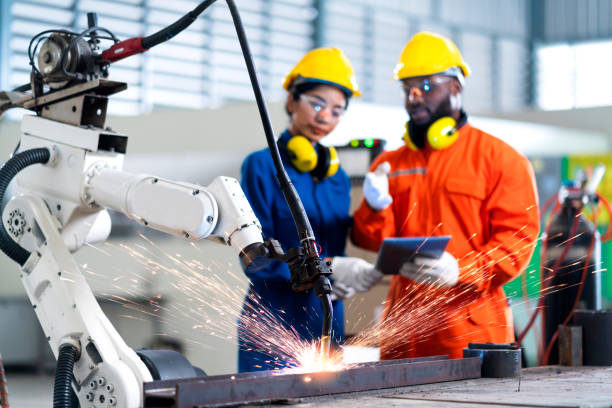
In today’s rapidly evolving industrial landscape, efficiency and precision have become more than just goals—they’re necessities. As the demand for streamlined operations and high-quality production grows, robotic welding technology has emerged as a transformative force in manufacturing and construction. Companies around the world are turning to robotic systems to boost productivity, reduce labor costs, and enhance the consistency of their welds. From skyscraper frameworks to shipbuilding and structural steel fabrication, robotic welding has proven its value in diverse sectors. Particularly in countries like the USA, UK, Germany, Singapore, and the Netherlands, businesses are investing heavily in automated welding solutions. With the rise of laser technology and smart robotics, this field is reshaping the way work is done. This article explores how advanced robotic welding systems are being used across global markets, what makes them so effective, and how companies can capitalize on this technology to stay ahead in an increasingly competitive industry.
The Rise of Robotic Welding in Global Construction
Robotic welding systems are no longer futuristic tools—they are present-day essentials in the global construction industry. In the UK, manufacturers and builders have been integrating robotic welding to improve efficiency and reduce the margin of error in complex welding tasks. The demand for robotic welding in the UK has grown significantly, particularly in automotive and heavy steel manufacturing, where consistency is key.
Similarly, advanced robotic welding systems for construction companies in the USA have revolutionized how large-scale infrastructure projects are executed. These systems reduce reliance on manual welders, which is particularly crucial given the skilled labor shortages many regions are facing. The speed and precision of robotic arms allow American construction companies to take on more ambitious projects while maintaining high safety and quality standards.
Advanced Systems Tailored for Regional Needs
Different regions have unique demands, and robotic welding systems are now being tailored to suit specific construction challenges. For instance, advanced robotic welding systems for construction companies in Germany focus heavily on integration with existing smart factory infrastructures. German manufacturers prioritize systems that can communicate with other machines, collect data, and optimize performance in real-time.
In contrast, advanced robotic welding systems for construction companies in the Netherlands are designed to support modular construction techniques and sustainable building practices. The Netherlands, being a global leader in eco-friendly construction, utilizes robotic systems that reduce waste and improve material efficiency. These robots often work on prefabricated building elements, contributing to faster project delivery without compromising on environmental standards.
Singapore’s Push Toward Smart Construction
The push for digitalization in Southeast Asia has made advanced robotic welding systems for construction companies in Singapore a top priority for the nation’s tech-forward development strategy. Singapore’s limited labor pool and emphasis on vertical construction make robotic welding a natural fit. With compact, high-performance robotic arms, construction firms in Singapore can weld structural components in confined urban job sites without sacrificing output quality or speed.
Moreover, the integration of AI and machine learning into robotic welding systems in Singapore enables predictive maintenance and real-time quality control, further enhancing productivity. These innovations reduce downtime and ensure that every weld meets stringent safety and durability standards.
Technological Advancements in Welding Precision
One of the most significant innovations in this field is the rise of laser welding technology. In precision-focused markets like the UK, the demand for a laser welder for sale in the UK continues to rise. Laser welding offers advantages such as deep penetration, minimal heat-affected zones, and extremely clean welds, making it ideal for industries requiring detailed and high-quality finishing.
For construction companies, adopting laser welding solutions can drastically reduce rework and material costs. In sectors like aerospace, automotive, and specialized steel fabrication, the accuracy of laser welding allows for the production of complex components with fewer errors and faster turnaround times.
The Business Impact of Robotic Welding
The investment in robotic welding goes beyond mere automation. These systems contribute to substantial returns through reduced labor costs, minimized error rates, and improved worker safety. In competitive markets such as the USA and Germany, companies leveraging advanced robotic welding systems for construction gain a measurable edge over those relying solely on manual processes.
These systems also ensure better compliance with international welding standards and enable companies to expand their service offerings. Whether it’s precision welding for high-rise buildings or heavy-duty joints in bridges, robotic systems provide the versatility required to meet diverse project demands.
A Future Defined by Smart Welding
As industries continue to embrace digital transformation, robotic welding will remain a cornerstone of modern construction and manufacturing. Whether you're exploring a laser welder for sale in the UK or implementing advanced robotic welding systems for construction companies in Singapore, the message is clear: automation enhances quality, speed, and scalability.
With global leaders like the USA, Germany, the Netherlands, Singapore, and the UK adopting advanced robotic solutions, the future of welding is smarter, safer, and more productive than ever. Companies that invest in this technology today will not only meet today’s demands but will also be well-positioned to tackle the challenges of tomorrow.

